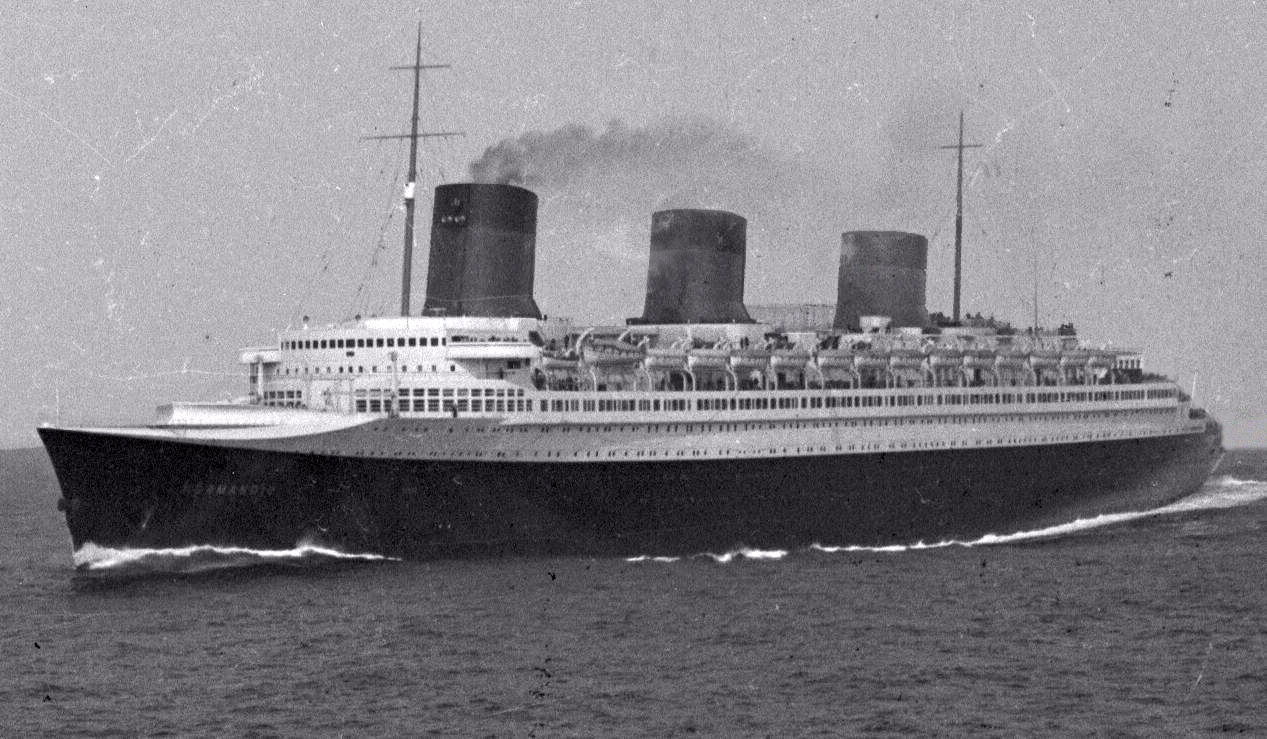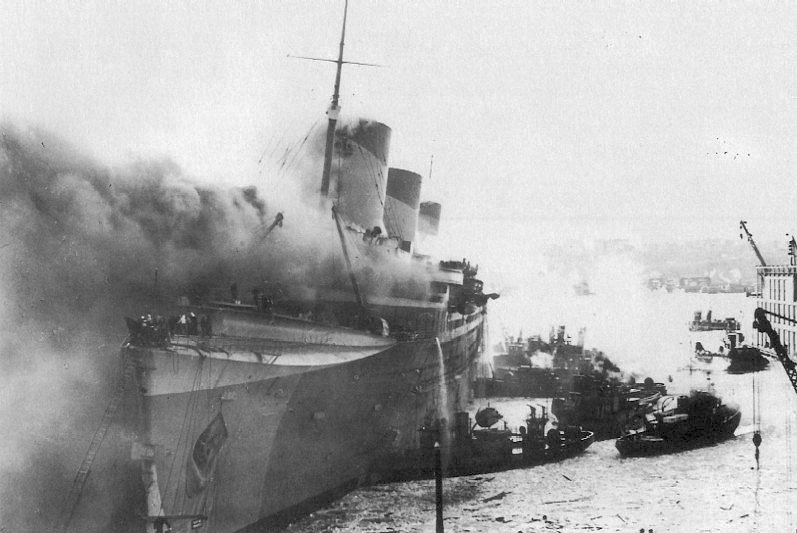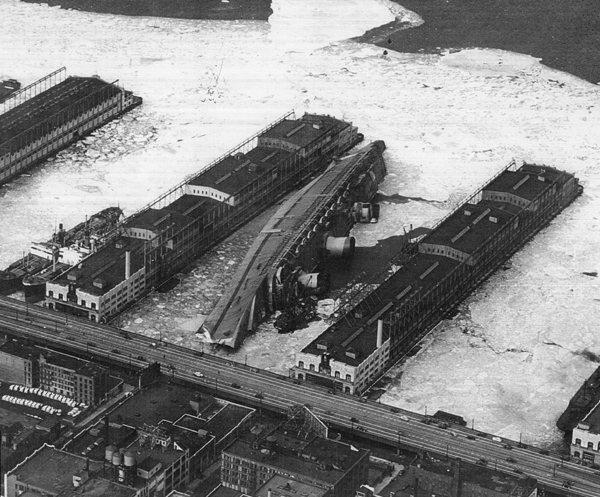Welcome to DU!
The truly grassroots left-of-center political community where regular people, not algorithms, drive the discussions and set the standards.
Join the community:
Create a free account
Support DU (and get rid of ads!):
Become a Star Member
Latest Breaking News
General Discussion
The DU Lounge
All Forums
Issue Forums
Culture Forums
Alliance Forums
Region Forums
Support Forums
Help & Search
General Discussion
Related: Editorials & Other Articles, Issue Forums, Alliance Forums, Region Forums78 Years Ago Today; Death of SS Normandie
https://en.wikipedia.org/wiki/SS_Normandie

The SS Normandie was an ocean liner built in Saint-Nazaire, France, for the French Line Compagnie Générale Transatlantique (CGT). She entered service in 1935 as the largest and fastest passenger ship afloat; she remains the most powerful steam turbo-electric-propelled passenger ship ever built.
Her novel design and lavish interiors led many to consider her the greatest of ocean liners. Despite this, she was not a commercial success and relied partly on government subsidy to operate. During service as the flagship of the CGT, she made 139 westbound transatlantic crossings from her home port of Le Havre to New York. Normandie held the Blue Riband for the fastest transatlantic crossing at several points during her service career, during which the RMS Queen Mary was her main rival.
During World War II, Normandie was seized by U.S. authorities at New York and renamed USS Lafayette. In 1942, the liner caught fire while being converted to a troopship, capsized onto her port side and came to rest on the mud of the Hudson River at Pier 88, the site of the current New York Passenger Ship Terminal. Although salvaged at great expense, restoration was deemed too costly and she was scrapped in October 1946.
<snip>
https://en.wikipedia.org/wiki/SS_Normandie#Fire_and_capsizing
Fire and capsizing

Lafayette (AP-53) afire at New York harbor on 9 February 1942
At 14:30 on 9 February 1942, sparks from a welding torch used by Clement Derrick ignited a stack of life vests filled with flammable kapok that had been stored in the first-class lounge. The woodwork had not yet been removed, and the fire spread rapidly. The ship had a very efficient fire protection system, but it had been disconnected during the conversion and its internal pumping system was deactivated. The New York City fire department's hoses, unfortunately, did not fit the ship's French inlets. Before the fire department arrived, approximately 15 minutes after fire broke out, all onboard crew were using manual means in a vain attempt to stop the blaze. A strong northwesterly wind blowing over Lafayette's port quarter swept the blaze forward, eventually involving the three upper decks of the ship within an hour of the start of the conflagration. Capt. Coman, along with Capt. Simmers, arrived about 15:25 to see his huge prospective command in flames.
As firefighters on shore and in fire boats poured water on the blaze, the ship developed a dangerous list to port due to water pumped into the seaward side by fireboats. The ship's designer Vladimir Yourkevitch arrived at the scene to offer expertise, but he was barred by harbor police. His suggestion was to enter the vessel and open the sea-cocks. This would flood the lower decks and make her settle the few feet to the bottom. With the ship stabilised, water could be pumped into burning areas without the risk of capsize. The suggestion was rejected by the commander of the 3rd Naval District, Rear Admiral Adolphus Andrews.
Between 17:45 and 18:00 on 9 February 1942, authorities considered the fire under control, and began winding down operations until 20:00. Water entering the ship through submerged openings and flowing to the lower decks negated efforts to counter-flood, and Lafayette's list gradually increased to port. Shortly after midnight, Rear Adm. Andrews ordered Lafayette abandoned, and the ship continued to list, a process hastened by the 6,000 tons of water that had been played on her. New York fire officials were concerned that the fire could spread to the nearby city buildings. Lafayette eventually capsized during the mid watch (02:45) on 10 February, nearly crushing a fire boat, and came to rest on her port side at an angle of approximately 80 degrees. Recognising that his incompetence had caused the disaster, Admiral Andrews ordered all pressmen barred from viewing the moment of capsize in an effort to lower the level of publicity.

Normandie, renamed USS Lafayette, lies capsized in the frozen mud of her New York Pier the winter of 1942
One man died in the tragedy — Frank "Trent" Trentacosta, 36, of Brooklyn, a Robins' employee and a member of the fire watch. Some 94 USCG and USN sailors, including some from Lafayette's pre-commissioning crew and men assigned to the receiving ship Seattle, 38 fire fighters, and 153 civilians were treated for various injuries, burns, smoke inhalation, and exposure.
Saboteur (film)
The ruined Lafayette after the fire can be seen briefly in the film Saboteur (1942). The ship is not identified in the film, but the antagonist smiles when he sees it, suggesting that he was responsible. Alfred Hitchcock, the director, later said that "the Navy raised hell" about the implication that their security was so poor.
</snip>

The SS Normandie was an ocean liner built in Saint-Nazaire, France, for the French Line Compagnie Générale Transatlantique (CGT). She entered service in 1935 as the largest and fastest passenger ship afloat; she remains the most powerful steam turbo-electric-propelled passenger ship ever built.
Her novel design and lavish interiors led many to consider her the greatest of ocean liners. Despite this, she was not a commercial success and relied partly on government subsidy to operate. During service as the flagship of the CGT, she made 139 westbound transatlantic crossings from her home port of Le Havre to New York. Normandie held the Blue Riband for the fastest transatlantic crossing at several points during her service career, during which the RMS Queen Mary was her main rival.
During World War II, Normandie was seized by U.S. authorities at New York and renamed USS Lafayette. In 1942, the liner caught fire while being converted to a troopship, capsized onto her port side and came to rest on the mud of the Hudson River at Pier 88, the site of the current New York Passenger Ship Terminal. Although salvaged at great expense, restoration was deemed too costly and she was scrapped in October 1946.
<snip>
https://en.wikipedia.org/wiki/SS_Normandie#Fire_and_capsizing
Fire and capsizing

Lafayette (AP-53) afire at New York harbor on 9 February 1942
At 14:30 on 9 February 1942, sparks from a welding torch used by Clement Derrick ignited a stack of life vests filled with flammable kapok that had been stored in the first-class lounge. The woodwork had not yet been removed, and the fire spread rapidly. The ship had a very efficient fire protection system, but it had been disconnected during the conversion and its internal pumping system was deactivated. The New York City fire department's hoses, unfortunately, did not fit the ship's French inlets. Before the fire department arrived, approximately 15 minutes after fire broke out, all onboard crew were using manual means in a vain attempt to stop the blaze. A strong northwesterly wind blowing over Lafayette's port quarter swept the blaze forward, eventually involving the three upper decks of the ship within an hour of the start of the conflagration. Capt. Coman, along with Capt. Simmers, arrived about 15:25 to see his huge prospective command in flames.
As firefighters on shore and in fire boats poured water on the blaze, the ship developed a dangerous list to port due to water pumped into the seaward side by fireboats. The ship's designer Vladimir Yourkevitch arrived at the scene to offer expertise, but he was barred by harbor police. His suggestion was to enter the vessel and open the sea-cocks. This would flood the lower decks and make her settle the few feet to the bottom. With the ship stabilised, water could be pumped into burning areas without the risk of capsize. The suggestion was rejected by the commander of the 3rd Naval District, Rear Admiral Adolphus Andrews.
Between 17:45 and 18:00 on 9 February 1942, authorities considered the fire under control, and began winding down operations until 20:00. Water entering the ship through submerged openings and flowing to the lower decks negated efforts to counter-flood, and Lafayette's list gradually increased to port. Shortly after midnight, Rear Adm. Andrews ordered Lafayette abandoned, and the ship continued to list, a process hastened by the 6,000 tons of water that had been played on her. New York fire officials were concerned that the fire could spread to the nearby city buildings. Lafayette eventually capsized during the mid watch (02:45) on 10 February, nearly crushing a fire boat, and came to rest on her port side at an angle of approximately 80 degrees. Recognising that his incompetence had caused the disaster, Admiral Andrews ordered all pressmen barred from viewing the moment of capsize in an effort to lower the level of publicity.

Normandie, renamed USS Lafayette, lies capsized in the frozen mud of her New York Pier the winter of 1942
One man died in the tragedy — Frank "Trent" Trentacosta, 36, of Brooklyn, a Robins' employee and a member of the fire watch. Some 94 USCG and USN sailors, including some from Lafayette's pre-commissioning crew and men assigned to the receiving ship Seattle, 38 fire fighters, and 153 civilians were treated for various injuries, burns, smoke inhalation, and exposure.
Saboteur (film)
The ruined Lafayette after the fire can be seen briefly in the film Saboteur (1942). The ship is not identified in the film, but the antagonist smiles when he sees it, suggesting that he was responsible. Alfred Hitchcock, the director, later said that "the Navy raised hell" about the implication that their security was so poor.
</snip>
InfoView thread info, including edit history
TrashPut this thread in your Trash Can (My DU » Trash Can)
BookmarkAdd this thread to your Bookmarks (My DU » Bookmarks)
0 replies, 618 views
ShareGet links to this post and/or share on social media
AlertAlert this post for a rule violation
PowersThere are no powers you can use on this post
EditCannot edit other people's posts
ReplyReply to this post
EditCannot edit other people's posts
Rec (5)
ReplyReply to this post